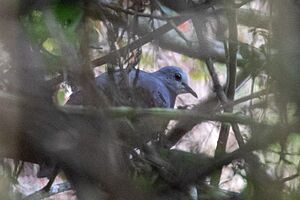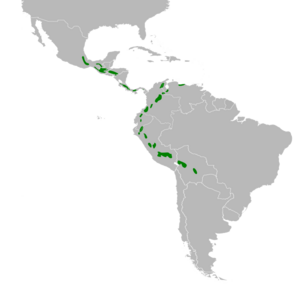Maroon-chested ground dove facts for kids
Quick facts for kids Maroon-chested ground dove |
|
|---|---|
 |
|
| Conservation status | |
| Scientific classification | |
| Genus: |
Paraclaravis
|
| Species: |
mondetoura
|
 |
|
| Synonyms | |
|
Claravis mondetoura |
|
The maroon-chested ground dove (Paraclaravis mondetoura) is a small bird that belongs to the Columbidae family, which includes doves and pigeons. This beautiful bird can be found in many countries across Central and South America, including Bolivia, Colombia, Costa Rica, Ecuador, El Salvador, Guatemala, Honduras, Mexico, Panama, Peru, and Venezuela.
Contents
About This Bird's Name
Scientists often group animals together based on how they are related. The maroon-chested ground dove was first placed in a group called Claravis. However, in 2018, scientists decided it was different enough to be moved to a new group, or genus, called Paraclaravis. Another bird, the purple-winged ground dove, is also in this new group.
Some bird experts, like the International Ornithological Committee (IOC), believe there is only one type of maroon-chested ground dove. But other groups, like the Clements taxonomy, think there are six slightly different kinds, called subspecies. These subspecies are:
- P. m. ochoterena
- P. m. salvini
- P. m. umbrina
- P. m. pulchra
- P. m. mondetoura
- P. m. inca
It's worth noting that some scientists think a few of these subspecies might just be individual differences, not truly separate types.
What the Maroon-chested Ground Dove Looks Like
These doves are not very big. Males are about 18 to 24 centimeters (7 to 9.4 inches) long. Females are a bit smaller, usually 19 to 22 centimeters (7.5 to 8.7 inches) long. Both males and females weigh around 89 to 95 grams (3.1 to 3.4 ounces), which is about the weight of a small apple.
Adult male doves have a grayish-white forehead, face, and chin. Their chest is a dark purple color, which fades to gray on their belly. Their back and wings are blue-gray. When their wings are folded, you can see two wide, dark stripes. The feathers in the middle of their tail are gray, while the outer ones are white. They have bright orange eyes surrounded by bare yellow skin.
Adult females look a bit different. They are mostly brown with a cinnamon-colored face. Their wing stripes are not as clear as the males'. Young doves look similar to the adult females but have more reddish feathers. The different subspecies might have slight variations in their colors.
Where They Live and What They Like
The maroon-chested ground dove lives in scattered areas from southeastern Mexico all the way down to Peru and Bolivia.
They prefer to live in thick, dense plants found in wet montane forests. These are forests found in mountainous regions. They also like the edges of these forests and thickets of secondary forest, which are forests that have grown back after being cut down. These doves are especially fond of areas with lots of bamboo.
You can find them at different heights depending on the country. In Mexico, they live between 1,200 and 2,500 meters (3,900 and 8,200 feet) above sea level. In Costa Rica, they are found between 900 and 3,000 meters (3,000 and 9,800 feet). In Panama, they live between 1,000 and 2,100 meters (3,300 and 6,900 feet), and in the Andes mountains, they are seen between 1,300 and 2,600 meters (4,300 and 8,500 feet).
How They Behave
What They Eat
The maroon-chested ground dove looks for its food on the ground. They mostly eat seeds and fallen fruit. Usually, they forage alone or in pairs. However, sometimes they gather in small groups of up to 15 birds to feed. Bamboo seeds are a very important part of their diet. They will stay in an area only as long as the bamboo plants are producing seeds.
Reproduction and Life Cycle
Scientists don't know a lot about how these doves breed. It's thought that they might nest in loose groups, rather than completely alone. The only nest that has been described was a simple platform with two eggs. It was found in Chusquea bamboo plants in the mountains of southeastern Ecuador.
Their Song
The maroon-chested ground dove has a unique song. It sounds like a series of low-pitched coos that rise slightly. You might hear it as "cuWOOP.....cuWOOP.....cuWOOP...".
Their Conservation Status
The IUCN (International Union for Conservation of Nature) has evaluated the maroon-chested ground dove. They have assessed it as a species of "Least Concern." This means that, for now, it is not considered to be in immediate danger of extinction.
However, this bird is thought to be uncommon to rare in many areas. Experts believe it could be in danger if a lot of deforestation (cutting down forests) continues where it lives. Protecting its forest home, especially areas with bamboo, is important for its future.


